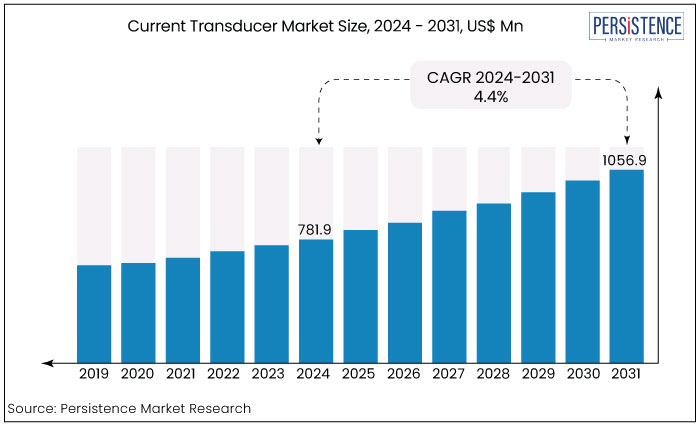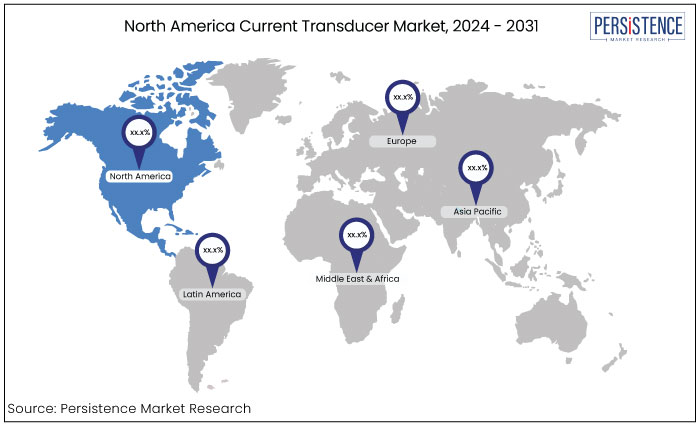Industry: Energy & Utilities
Published Date: September-2024
Format: PPT*, PDF, EXCEL
Delivery Timelines: Contact Sales
Number of Pages: 172
Report ID: PMRREP34801
The current transducer market is estimated to increase from US$781.9 Mn in 2024 to US$1056.9 Mn by 2031. The market is projected to record a CAGR of 4.4% during the forecast period from 2024 to 2031. The increased adoption of electric vehicles and a robust charging infrastructure surges the demand for current transducers in battery management and powertrain systems. North America leads the global market owing to the robust infrastructure development and automation in automotive industry.

Key Highlights of the Market
|
Market Attributes |
Key Insights |
|
Current Transducer Market Size (2024E) |
US$781.9 Mn |
|
Projected Market Value (2031F) |
US$1056.9 Mn |
|
Global Market Growth Rate (CAGR 2024 to 2031) |
4.4% |
|
Historical Market Growth Rate (CAGR 2019 to 2023) |
3.7% |
North American market for current transducers is significant, driven by technological progress across electronics, automotive, and renewable energy fields. This innovation fuels the need for advanced current transducers that offer improved accuracy, reliability, and integration. Tech hubs in Silicon Valley and other regions across the U.S. and Canada are often at the forefront of these advancements, influencing the trajectory of sensor technology in the industry.
The U.S. is home to many leading technology companies and research institutions that drive innovation in current transducer technology. Advances in sensor technology from these entities often set trends for the industry.
The extensive demand across various sectors such as electronics, automotive, and renewable energy creates a substantial market for current transducers. Growing needs of the industries in the United States for precise and reliable measurement solutions fuel this demand.

|
Category |
Market Share in 2024 |
|
Current Sensing Method - Direct Current Sensing |
70% |
Based on current sensing method, the current transducer market is segmented into direct current sensing, and in-direct current sensing. Among these, the direct current sensing segment dominates the market.
The swift proliferation of renewable energy systems, including solar and wind power, has heightened the necessity for effective DC sensing. Such systems frequently necessitate meticulous monitoring and regulation of DC currents to guarantee optimal performance and integration with the grid.
|
Category |
Market Share in 2024 |
|
Loop Type - Closed Loop |
64% |
Based on loop type, the market for current transducer market is classified into open loop and closed loop. Among these, the closed loop segment dominates the market. Closed loop current transducers are essential in numerous applications because they can deliver accurate and dependable current readings.
Closed loop current transducers are essential components of energy management systems, which are progressively utilized to improve energy efficiency and decrease power usage. Its capacity to provide precise and instantaneous data facilitates optimizing energy use and the mitigation of losses.
A current transducer is a device that converts current into electric current that meets industrial requirements. Current transducers exhibit several characteristics including linearity, dimensional stability, and the capacity to sustain electric flow inside the system. It is utilized throughout multiple industries, including automotive, electrical components, transportation, aerospace, construction, and other end-use sectors.
The expansion of the present transducer market is propelled by increasing urbanization, rising disposable income, and heightened consumer desire for electric vehicles. The current transducer is dependable and efficient and functions as a power analyzer possessing current conversion capabilities, which makes it widely utilized in many electronic components.
The rapid population growth in both developed and developing economies along with enhancements in living standards and the rising demand for global energy consumption, has compelled power plants resulting in the widespread utilization of current transducers in electrical devices and components. It facilitates the conversion of current into industrial-standard electrical signals, enhancing electronic components' overall efficiency. This aspect is anticipated to expand the existing transducer market throughout the forecast year.
The current transducer market has experienced steady growth historically driven by increasing demand for efficient energy management systems, and the growing need for industrial automation.
From 2019 to 2023, the market expanded due to the surge in smart grid technologies and electrical infrastructure development. The market has also benefited from advancements in sensor technologies and the rising use of current transducers in electric vehicles (EVs), power plants, and industrial equipment.
The market is expected to witness a robust growth rate from 2024 to 2031, driven by the continued expansion of renewable energy sectors and the growing need for monitoring and optimizing energy consumption in industrial and commercial applications.
Key factors such as government initiatives for energy efficiency, the electrification of transportation, and advancements in IoT-based solutions are likely to further fuel demand. Asia Pacific particularly China and India are projected to be significant contributors to this growth given the rapid industrialization and infrastructure developments in these regions.
Increasing Adoption of Renewable Energy
The shift toward renewable energy sources such as solar and wind power has significantly driven the demand for current transducers. Such devices play a critical role in monitoring and controlling current flow in renewable energy systems to ensure efficient energy conversion and transmission.
With global efforts to reduce carbon emissions and transition towards cleaner energy, the integration of solar inverters, wind turbines, and grid-tied energy systems is rising. Current transducers help provide accurate data on current flow, which is essential for optimizing energy production and minimizing losses in renewable energy setups.
As countries worldwide increase their renewable energy capacities, the demand for current transducers is expected to rise substantially.
Growing Electrification of Transportation
The electrification of the transportation sector particularly the rise of electric vehicles (EVs), is another key driver for the current transducer market. EVs rely heavily on electrical systems, and current transducers are used to monitor power usage, battery management, and motor control systems to ensure efficiency.
The global EV market is growing rapidly due to stringent emission regulations and government incentives promoting zero-emission vehicles. Current transducers are vital in measuring the current flowing through charging systems, powertrains, and other components, helping to improve vehicle performance, safety, and battery longevity. This rising adoption of EVs is expected to drive significant demand for current transducers in the automotive industry.
Lack of Standardization and Compatibility Issues
The absence of standardized protocols and compatibility issues with different electrical systems and devices can act as a significant growth restraint for the current transducer market. As transducers are used across a wide range of industries ensuring seamless integration with various systems, especially in complex environments.
Differences in voltage levels, current types (AC/DC), and technical specifications often lead to compatibility problems that require costly customization or modifications to existing infrastructure.
The lack of uniform standards increases the complexity of implementation and can lead to hesitancy in adopting current transducers, especially in industries that require interoperability across multiple devices and platforms. As a result, the market may face delays in widespread adoption, particularly in emerging regions where technological infrastructure varies widely.
Growth of Electric Vehicles (EVs) and Charging Infrastructure
One of the most transformative opportunities for the current transducer market lies in the rapid expansion of electric vehicles (EVs) and the associated charging infrastructure. As EV adoption accelerates globally, there is a growing need for accurate current monitoring in EV batteries, charging systems, and electric powertrains to ensure energy efficiency, performance, and safety.
Current transducers provide real-time monitoring of power flow enabling optimized battery management systems (BMS), regenerative braking, and efficient energy transfer during charging and discharging processes.
The growing investment in public and residential EV charging stations offers further opportunities for current transducer manufacturers to provide advanced monitoring solutions to manage energy loads, and improve the lifespan of charging systems. The ongoing electrification trend presents a long-term growth avenue for the current transducer market, particularly as governments and companies push for zero-emission vehicles.
Integration with Smart Grids and Energy Storage Systems
The rise of smart grids and the increasing need for efficient energy management systems represent another transformative opportunity for the current transducer market. As nations modernize their electrical grids to incorporate renewable energy sources, current transducers are critical in providing the precise, real-time data needed for effective energy distribution.
Such devices play an essential role in balancing energy loads, reducing wastage, and ensuring stable grid operations in both decentralized and centralized energy setups. The growing adoption of energy storage systems, like large-scale batteries requires accurate current monitoring to optimize the charge/discharge cycles and maintain system reliability.
As smart grids continue to evolve, the need for current transducers will expand, providing market players with the opportunity to innovate and develop more intelligent, IoT-enabled monitoring solutions.
The current transducer market is characterized by a competitive landscape with several key global and regional players. Leading companies include LEM, Honeywell, Tamura Corporation, and ABB, all of which dominate the market through their extensive product portfolios and technological innovations.
Key players in the market focus on delivering highly accurate and efficient transducers for industrial, automotive, and renewable energy applications. Strategic activities like mergers, acquisitions, and partnerships are common and aimed at expanding product offerings and enhancing geographic reach. Small companies and new entrants are targeting niche segments with customized solutions.
Technological advancements, especially in IoT integration and smart energy management are shaping the competitive dynamics making innovation and cost-effectiveness critical for market positioning.
Recent Industry Developments in the Current Transducer Market
|
Attributes |
Details |
|
Forecast Period |
2024 to 2031 |
|
Historical Data Available for |
2019 to 2023 |
|
Market Analysis |
US$ Billion for Value |
|
Key Regions Covered |
|
|
Key Market Segments Covered |
|
|
Key Companies Profiled in the Report |
|
|
Report Coverage |
|
|
Customization & Pricing |
Available upon request |
By Current Sensing Method
By Loop Type
By Technology
By Region
To know more about delivery timeline for this report Contact Sales

Growing electrification of transportation fuels the demand for current transducer.
ABB, Texas Instrument Inc., Johnson Control Inc., Topstek Inc., are some of the key players in the market.
North America is set to account for significant share of the market.
The closed loop type to record significant market share in 2024.
The growth of electric vehicles offers compelling opportunity in the market.